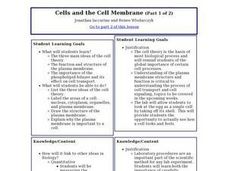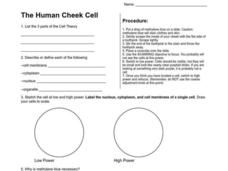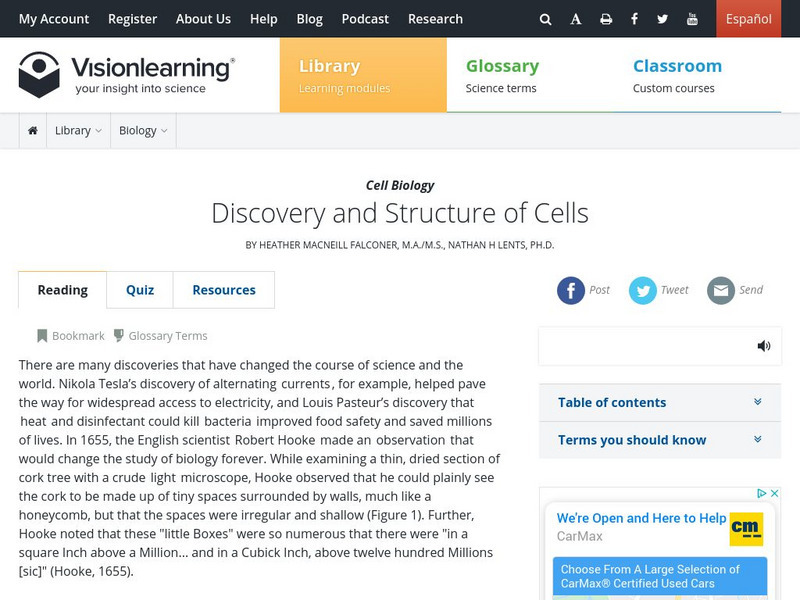Pace University
Grade 6-8 Living Things
What characterizes a living thing? Scholars explore the concept during a differentiated instruction unit on living things. They perform lab experiments to determine how animals adapt to stimuli, watch videos and learn about...
Columbus City Schools
Cell-abrate!
Lights, camera, action! With the cell at center stage, guide your seventh grade biologists through the tiny drama that plays out within every living thing. Then, enjoy the show as they portray the organelles they've studied—a performance...
Virginia Department of Education
Cell Parts
What do a bird, an egg, a rabbit, and a toad all have in common? This fun-filled resource explains the similarities and differences between cells and how all cells are similar, yet all are different. Learners begin by depicting a...
Columbus City Schools
Let’s Get Theoretical About Cells
Get up close and personal with cells in a hands-on journey to discover what makes up living things. Scholars learn valuable microscope skills, delve into the Modern Cell Theory, and gain insight into how cells reproduce. The included lab...
Curated OER
Early Scientists' Contributions
Five scientists and their contributions to modern cell theory are listed, one person per slide. It concludes by having viewers answer recap questions. This simple presentation can be used on the first day of your unit on cells...
Curated OER
Cell Structure
Your accelerated biology learners will add to their understanding of cell structure with this resource. Taking them beyond the basics of mitochondria and chromatin, it also queries them about actin microfilaments and the extracellular...
Curated OER
Cells and the Cell Membrane
Students investigate the properties of cell membranes by isolating the membrane surrounding chicken eggs. They set up an experiment by placing eggs in a vinegar solution for three days. A powerpoint lecture emphasizes the structure of...
Curated OER
7th Science Quiz
This seventh grade life science quiz has a professional appearance and well-written multiple-choice questions. However, it seems to cover too broad a variety of biology topics for only 15 questions to fully assess. There is one question...
Curated OER
The Body Part of Cells
Eighth graders are introduced to cell organelles and their functions and the they define the differences between animal and plant cells. They write a paragraph explaining the difference between plant and animal cells and students...
Curated OER
Early Scientists
Expose your beginning biologists to the development of cell theory and the scientists who played significant roles. The slides do not present much detail, and there are no teachers' notes to guide your lecture. Review the slides as an...
Curated OER
Quiz on Cell Theory
In this cell theory quiz worksheet, students complete an on-line game, clicking on questions and matching answer cards and scoring 1 point per correct answer. Printable version available also.
Curated OER
The Characteristics of Living Things
Eighth graders explore the characteristics of living things. In this living things lesson plan, 8th graders review as a class the cell theory and the characteristics of living things. They answer questions about how to determine if...
Curated OER
The Human Cheek Cell
In this human cells worksheet, 7th graders complete a science experiment using human cheek cells. Students sketch the cells at high and lower power and label the cell nucleus, cytoplasm, and cell membrane.
Curated OER
Hands-on Cells
Students review the components of a cell and the differences between plant and animal cells by creating a three-dimensional model of each type of cell. In small groups, they use modeling clay and household object to construct their models.
Curated OER
Unit 3 Cell Structures: Cell Theory & Organelles
Students examine cell structures in depth. They decide what grade they want to work for and do the assignments for that grade. They complete various assignments on cell theory and organelles.
Curated OER
Understanding Cells
Students identify and define several related vocabulary terms. Students complete a short lab and complete the questions. Students create a cell crossword puzzle and play cell computer games through the included links.
Curated OER
Cells & Their Function
Students review cell theory, identify major organelles found in typical cell, describe function of each major organelle, compare plant and animal cells, and demostrate understanding that cancer is caused by uncontrolled division of cells.
Curated OER
Lesson Plan: The Cell- A Historical Perspective
Young scholars discover the impact the invention of the microscope had on scientific discovery as well as the concept of spontaneous generation and the cell theory. Students examine these scientific concepts through a WebQuest and by...
Curated OER
The Human Cheek Cell
Students list the parts of cell theory and describe and define vocabulary. For this cell lesson students complete a handout that includes sketching a cell.
Curated OER
Biology Word Search A
In this biology instructional activity, 9th graders identify and locate various vocabulary terms found in the study of living things. There are 31 biology terms located in the word search.
Georgia Department of Education
Ga Virtual Learning: Ap Biology: Welcome
This online course includes the exploration of several subjects in biology through field study and labs at an advanced level to deepen the students' understanding of biology.
TED Talks
Ted: Ted Ed: The Wacky History of Cell Theory
Video describes the development of the cell theory and some of the scientists and disagreements involved. [6:12] Includes a short quiz and a list of additional resources to explore.
Vision Learning
Visionlearning: Cell Biology: Discovery and Structure of Cells
Explanation of when the cell was discovered and how ideas have evolved into modern cell theory. Discover the cell structures and their functions.
CK-12 Foundation
Ck 12: Cell Biology
[Free Registration/Login may be required to access all resource tools.] Cells make up all living things but not all cells look alike. This activity introduces cells, cell theory, and the levels of organization in organisms.

























